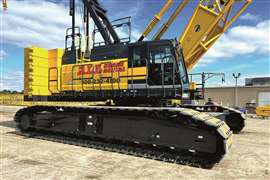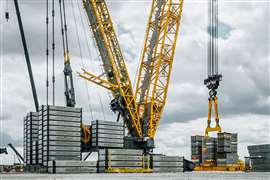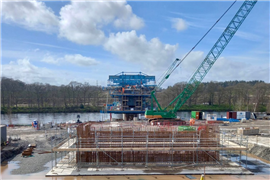Hinkley Point C - Five years on
29 September 2021
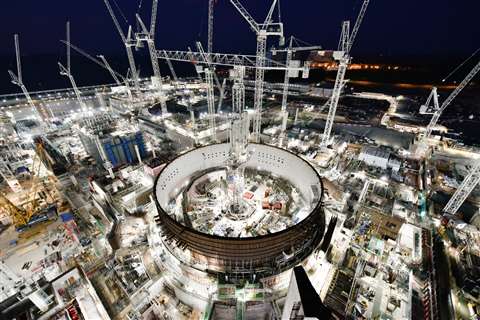 The first reactor unit and the blue steel columns of the turbine building illuminated against the Somerset skyline.
The first reactor unit and the blue steel columns of the turbine building illuminated against the Somerset skyline.
New video footage and photographs showing the progress of construction works to Hinkley Point C have been released, marking five years since the start of the project.
On 29 September 2016 - exactly five years ago today - the final contracts for the £23 billion (€26.6 billion) energy project were signed and works officially began.
Since then, the project has seen the installation of “the largest land-based crane in the world”, Big Carl, and the use of the biggest TBM ever used on a UK rail project.
Works at Hinkley Point C, which include the construction of two new nuclear reactors for energy provider EDF Energy, have so far resulted in 3,600 British companies securing contracts on the project, with around 22,000 workers across the country currently involved in its construction.
Said to be the UK’s first new nuclear power station for a generation, it will eventually provide enough “reliable low carbon electricity to meet 7% of the country’s needs”, and will help the UK meet its net zero carbon emission targets.
Stuart Crooks, Managing Director for Hinkley Point C, said, “Hinkley Point C is essential in the fight against climate change and for Britain’s energy security. It is delivering on its promise of boosting British jobs, skills and industry right across the country.”
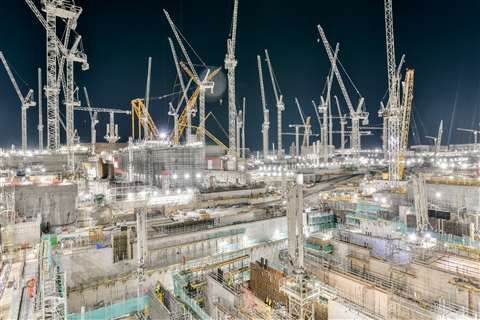 Looking back across the 36m ‘deep dig’ of Hinkley Point C’s pump house to the turbine building and crane, Big Carl - the largest land-based crane in the world.
Looking back across the 36m ‘deep dig’ of Hinkley Point C’s pump house to the turbine building and crane, Big Carl - the largest land-based crane in the world.
In addition to the involvement of major contractors such as Balfour Beatty, Kier, BAM, Bouygues and Laing O’Rourke, more than 400 large and small businesses in the North of England have been contracted to work on the nuclear station over the past five years.
While this has so far contributed around £1.2 billion (€1.4 billion) to the region’s economy, by the end of the project £18 billion (€20.8 billion) will have been spent with British businesses nationwide.
Around 6,300 of project’s 22,000 workers are currently based on the plant’s site in Somerset. While this is expected to increase to approximately 8,500 over the next 18 months, in total an estimated 74,000 people in Britain are due to work on Hinkley Point C before its completion in 2026.
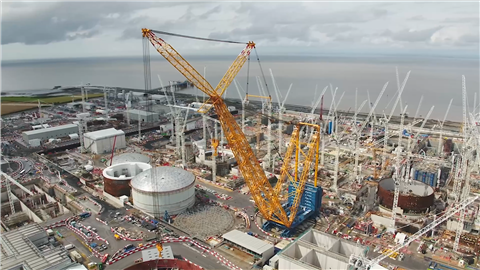 Five years after getting the go-ahead, the number of people across Britain working on the Hinkley Point C power station has reached 22,000.
Five years after getting the go-ahead, the number of people across Britain working on the Hinkley Point C power station has reached 22,000.
Believed to be one of the largest projects currently underway in Europe, Hinkley Point C has also played its part in helping bring people into the industry.
Since it began around 800 apprentices have been trained on the site.
According to project officials, “Hinkley Point C has worked with trades unions and colleges to fill skills shortages and bring new people into the construction and nuclear industries, with new training centres for welders, electricians, construction workers and nuclear specialists.”
Crooks said, “Covid-19 has challenged the project and its suppliers and I am proud of the enormous efforts made to keep the site safe and moving ahead. As we emerge from the worst of the pandemic, we can now create more jobs as we step up construction and manufacturing for the next phase of the project.”
Hinkley Point C - Progress Update
- The next prefabricated 17m high section of the first reactor building is complete and ready to be lifted into place by Big Carl - said to be the world’s largest crane.
- Work to build the 16m high floor for the first turbine and generator is under way, ready for the world’s most powerful “Arabelle” turbine which arrives later this year. Each turbine can produce more than 3% of the nation’s electricity, enough for more than 3m homes.
- 5 miles of cooling tunnels have been completed and six 5,000 tonne water intake heads are ready for installation.
- Work to install the 230 miles of pipes and 5,500 miles of cables is underway.
- Training for the first cohort of power station operators has begun.
- The country’s first “T-pylons” have been installed for the station’s 35-mile grid connection.
STAY CONNECTED


Receive the information you need when you need it through our world-leading magazines, newsletters and daily briefings.





